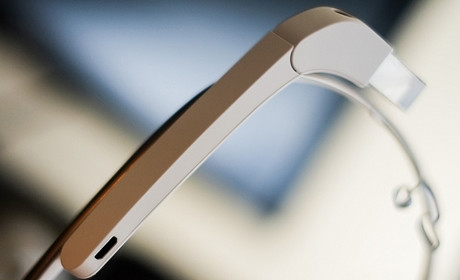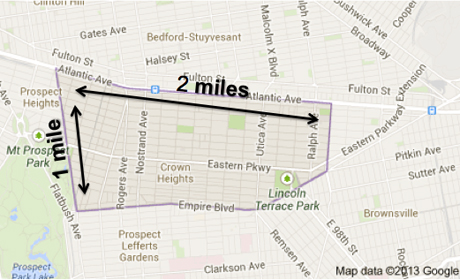
In August 1991, a three-day riot inflamed the Brooklyn community of Crown Heights. Fuelled by decades of tension and sparked by the accidental death of a child in a car accident, the West Indian and Orthodox Jewish communities that make up the two mile by one mile area erupted into racially-motivated violence.
More than 20 years later, the wounds have healed but some scars remain.
"There's a dual tension there," explained Hannah Roodman, director of Project 2x1, a documentary released in December focussing on the communities of Crown Heights and filmed largely through Google Glass.
"It's kind of locked in a certain apathy and distance between these two groups," she told Journalism.co.uk, "that we felt we could unlock through the practice of storytelling and through the intimacy of Google Glass."

The Crown Heights area of Brooklyn
In March 2013, Google ran a competition on Twitter to distribute a prototype of Glass to groups and individuals who would use it in an innovative or imaginative fashion. Mendy Seldowitz, a Crown Heights resident still in his teens at the time, suggested documenting his community and was picked to trial the new technology.
Seldowitz, Roodman and their team spent the summer filming the two communities, sharing Google Glass with individuals on both sides and documenting them at church or the synagogue, at school, at home, playing sports, relaxing and praying and eating together.
Through the more personal or private moments Roodman hoped to shed light on the inherent similarities between the two cultures, despite their apparent differences.
"What better way to do that then let those communities tell their own stories," Roodman said, "through their own rituals and identities and the routines that paint the big picture of their cultures with a device that captures life through their own eyes."
The premiere, on 8 December in a Crown Heights community centre, was attended by 300 local residents from both communities, the first time Roodman said she had seen the two groups come together in the time she had lived in the area.
The trailer for Project2x1
The film has had an "incredible" reception from the communities and wider media, she said, leading to features on the Huffington Post, New York Daily News and elsewhere, but how was Google Glass as a film-making and journalistic tool?
"It allows an audience to be in the head of the person who's wearing the device," said Roodman. "It was an experiment of this kind of intimacy that you get from capturing life through another persons eyes.
"Will that translate to a deeper level of empathy and listening on the receiving end, as an audience trying to understand these worlds? I think Glass takes you to a place you can't go by yourself or with a regular camera."
Key examples in Project 2x1 in this respect came from the filming of religious ceremonies, both by local pastors and rabbis, said Roodman. A documentary maker using traditional equipment could never record the same reactions from a congregation as from giving the pastor Google Glass, or film the segregated nature of Jewish prayer naturally, from a participants viewpoint.
"When I'm putting my camera in someone else's face, trying to capture them, there's a sense of objectification," said Roodman. "The experience of participation on the part of the film subject – to capture their own world, empowering them with the device – changes their perception and behaviour and makes them feel more comfortable."
However, the project was not without its flaws and battery life was a "major issue" for producers, forcing them to shoot for short periods before recharging Glass and potentially missing important moments. But with the official launch of the product still some way off, teething problems are to be expected, Roodman said.
"There's the shakiness as well," she said, "which offends some people who believe that, because we have devices that allow us to have such a steady, stable, beautiful picture, why would you go and shoot something that turns out shaky and could be nauseating?
"My answer to that is we're not here to make something super beautiful, we're here to make something super real and I think it's kind of cool to have that naturalness to it."
In comparison to a Go Pro – often the go-to device for first-person filming – Roodman said Glass came out on top for its versatility and intimacy, allowing viewers to look through the eyes of the subject quickly and easily.
"We were able to easily transition it between people's faces," she said. "So if we were filming basketball, it would be 'hey you, wear this', taking it off him and putting it on another guy, another guy, another guy. Seamlessly."
The Project 2x1 Kickstarter campaign video
The 30-minute film was funded through Kickstarter and although Roodman said they had received suggestions to embark on similar projects in different communities since, she said it would be "difficult to pull off" without adequate funding.
"We've gotten feedback like 'hey there's a community in New Jersey that really could use a project like this'," she said. "Yeah, we would love to do it if the opportunity and financial support presents itself."
But what about the prospects for Glass?
"It could become a common and best practice feature in citizen journalism or in journalists facilitating this kind of work in the field," she said.
"I immediately think about all these revolutions and protesters around the world. There are a million places where this device could go and give people access to witness stories they would never normally see."
Hannah Roodman was interviewed for a podcast on wearables to be published tomorrow.
Free daily newsletter
If you like our news and feature articles, you can sign up to receive our free daily (Mon-Fri) email newsletter (mobile friendly).
Related articles
- New project InOldNews wants to improve representation in video journalism
- 38 mojo apps from BBC trainer Marc Blank-Settle
- 15 online communities for journalists you should know about
- Ukrainian journalists use smartphones to tell stories of displaced communities
- 10 video editing apps for mobile journalists









